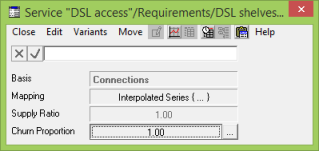Suppose instead you want to accelerate the introduction of a new resource, perhaps because its specification enables a new service feature.
 Save the model as WiMAX-DSL24
Save the model as WiMAX-DSL24
- Double-click the green requirement link between the DSL access service and the original DSL shelf resource. The Churn Proportion input is currently zero. This means that the customers connected via the original shelf will remain so until the end of its physical life.
- Now change the Churn Proportion to 1.0.

 Save and run the model
Save and run the model
- Look at the same graphs as in the previous exercise. What is different?
- Look at Resource Capacities for the original DSL shelf in particular. What has happened to the customers now?
- If there is time, experiment with intermediate values for the equipment churn proportion. Remember that there are only three shelves installed, so the options are fairly limited compared to a more extensive model.
-
Draw the graph Resource Operating Charge for both resources on the same graph.
You may find it helpful to set consolidation to Year and Graph Type to Unstacked to compare like with like.
- Compare this graph between the two extreme cases of end-of-life and immediate replacement. In what circumstances would it be reasonable to keep depreciating the old equipment after it is no longer being used by the DSL access service?
- Draw the Unit Utilisation graph for the original DSL shelf resource and note the redundant units.
- Save the workspace before moving on, to keep these latest charts.
 Things that you should have seen and understood
Things that you should have seen and understood
Accelerated migration, consolidation
Equipment Churn Proportion